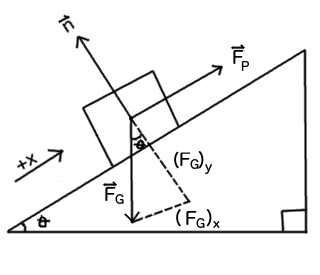How much work would it take to push a # 1 kg # weight up a # 4 m # plane that is at an incline of # (5pi) / 12 #?
1 Answer
Explanation:
I will assume that this is meant to be a frictionless plane.
We want to find the work required to push the object up the inclined plane—against any other forces that act against us.
Work done by a constant force is given by:
#color(blue)(W=F*dcos(theta))# where
#F# is the applied force,#d# is the displacement, and#theta# is the angle between the force and displacement vectors.
We are given:
-
#->"m"=1"kg"# -
#->"d"=4"m"# -
#->"incline of ramp, "phi=(5pi)/12#
In order to calculate the applied force required to find the work, which I will call
Diagram:

where
#vecn# is the normal force,#vecF_p# is the applied (pushing) force, and#vecF_G# is the force of gravity, decomposed into its parallel (x) and perpendicular (y) components. The angle of incline is#phi# .
We can sum the forces as:
#sumF_x=F_p-(F_G)_x=ma_x#
#sumF_y=n-(F_G)_y=ma_y#
We will assume dynamic equilibrium in both the horizontal and vertical directions. Vertically, this is because the object does not move up or down relative to the surface of the incline. Horizontally, we assume that the object does not accelerate as we push it since it is implied that we are looking for the minimum force required to move the object.
We can see then, with a bit of rearrangement, that the pushing force we apply must be equal to the parallel component of the force of gravity which acts against us. Therefore:
Using trigonometry, we can see from the diagram that
Going back to the work equation, we now have:
#W=mgsin(phi)*d*cos(theta)#
As said above,
#color(purple)(W=mgsin(phi)*d#
Substituting in our known values:
#W=(1"kg")(9.81"m"//"s"^2)sin((5pi)/12)*4"m"#
#37.9J"#
#~~38J"#
Note that this problem could also be solved using the work-energy theorem, where the work done is equal to the change in energy.
#W=DeltaE#
Since the object begins at the bottom of the incline and is pushed to the top, the ultimate change in energy will be the change in gravitational potential energy possessed by the object. Initially the object will have no gravitational potential energy, and finally it will have only gravitational potential energy.
#U_G=mgh#
You would need to use trigonometry to find
We can see from the diagram that
#h=rsin(theta)=4*sin((5pi)/12)#
So, we would find that:
#W=(1"kg")(9.81"m"//"s"^2)(4*sin((5pi)/12))#
#=37.9"J"#

